The Origin Of The Word ‘Cell’
It all started with a piece of cork…
 Science Diction is a bite-sized podcast about words—and the science stories behind them. Subscribe wherever you get your podcasts, and sign up for our newsletter.
Science Diction is a bite-sized podcast about words—and the science stories behind them. Subscribe wherever you get your podcasts, and sign up for our newsletter.
One day, the British scientist and “natural philosopher” Robert Hooke bent over a microscope that he’d constructed himself. He’d studied plenty of objects under the microscope before—the tip of a needle, a printed dot, snowflakes—but when he sketched and named this particular observation, he would take a word previously known for its religious connotations and bring it into the world of science.
Underneath the microscope was a piece of cork.
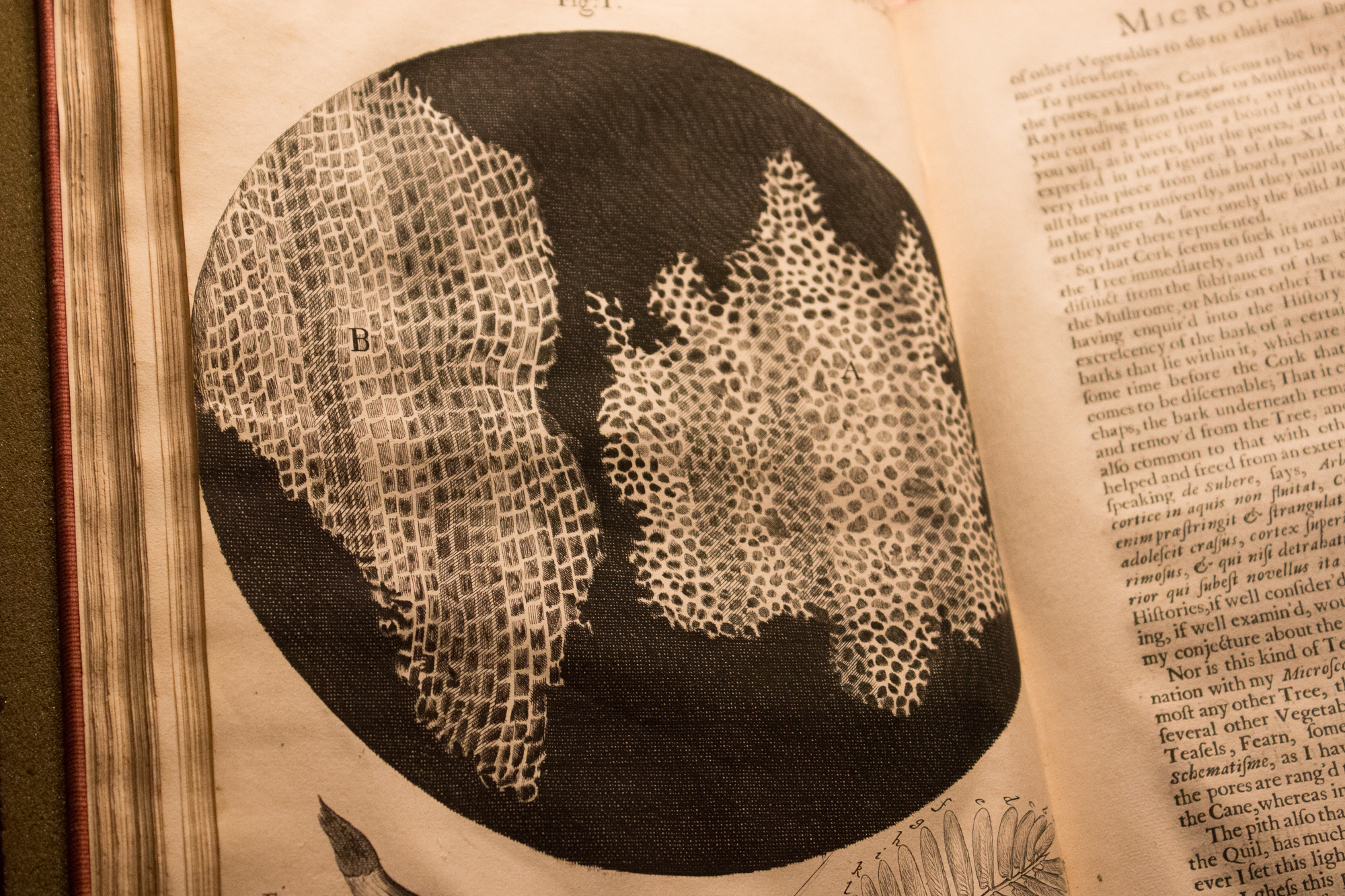
Hooke's illustration of a magnified piece of cork. Credit: Daniel Peterschmidt
When magnified, Hooke saw that the cork had a series of shallow, walled boxes or “pores.” We now know that Hooke was seeing the xylem structure, or specialized tissue in vascular plants, of the dead cork. The story goes that the small boxes reminded the scientist of the rooms that monks stayed in, which were called cellula. Later, when Hooke wrote about and illustrated what he saw under the microscope in his 1665 book Micrographia: Or Some Physiological Descriptions of Minute Bodies Made by Magnifying Glasses with Observations and Inquiries Thereupon, he used the word cell to describe what he was seeing—the first known person to do so in this context. While cell theory as we know it today wouldn’t begin to develop for another century and a half, his book is the reason we use the word cell to describe the smallest functional unit capable of life.
Micrographia was a bestseller when it debuted, says Arlene Shaner, historical collections librarian at the New York Academy of Medicine. It was so popular that reprints were issued, as well as a second edition two years later. “People were astonished by this book,” she says. “People had not seen this. [Today,] we see everything magnified—the world that we can see into has been so expanded that we get very jaded on some level. And I think this book does a lot to reawaken that sense of wonder in the natural world.”
“It is the great prerogative of Mankind above other Creatures, that we are not only able to behold the works of Nature, or barely to sustein [sic] our lives by them, but we have also the power of considering, comparing, altering, assisting, and improving them to various uses.”
—Robert Hooke, Preface to Micrographia
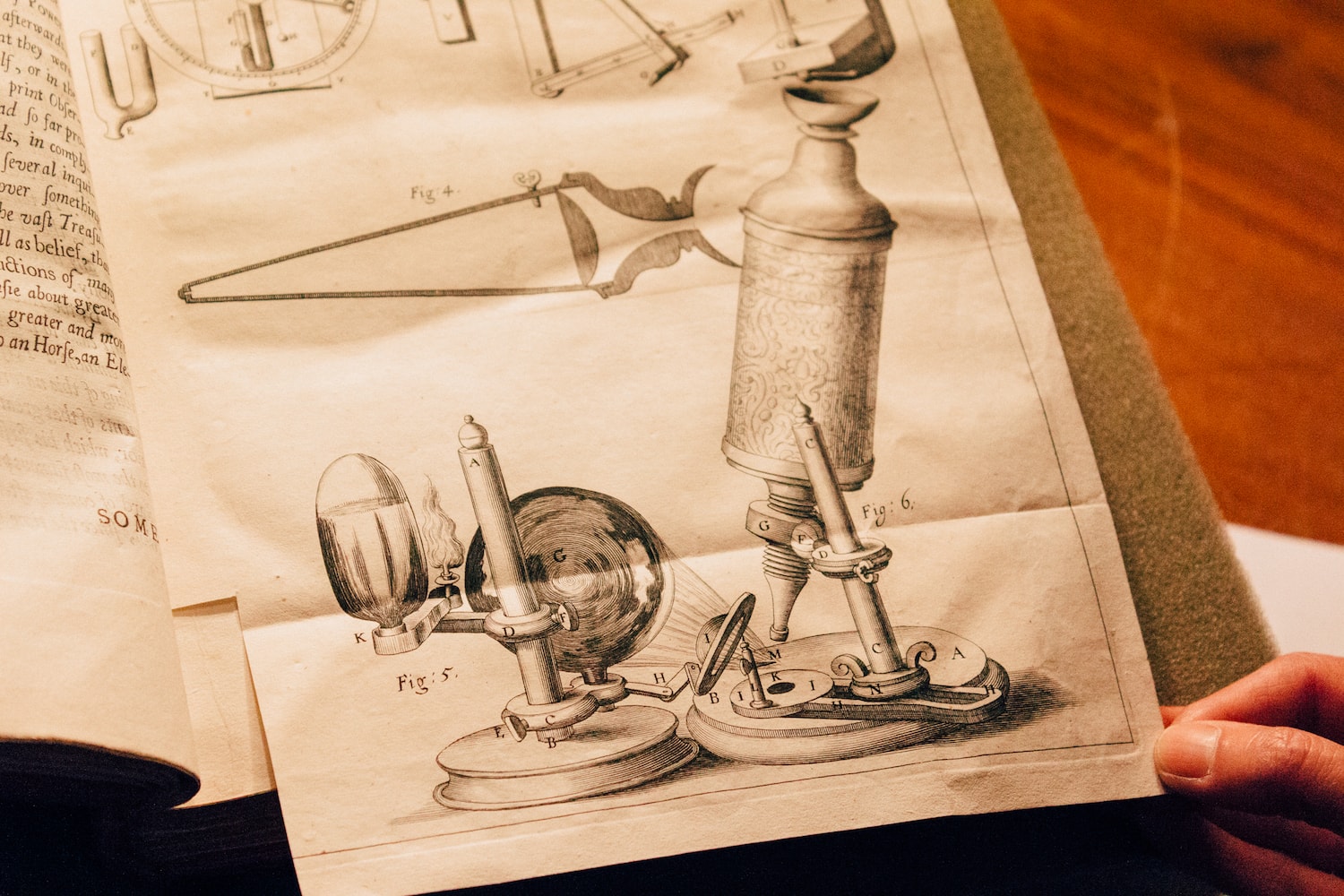
“Hooke was very talented in terms of his ability to make things,” says Shaner. “You can only imagine what he would’ve done with a Makerspace.” And when he built his microscope and began his observations, “he’s basically talking about how it is the privilege or the prerogative of mankind to be able to make these kinds of observations.”
Hooke began by examining inanimate objects, then turned his eye to living creatures. Science Friday recently got a chance to see an original copy of Micrographia at the New York Academy of Medicine and see some of the wonders he examined first-hand.
“As in Geometry, the most natural way of beginning is from a Mathematical point; so is the same method in Observations and Natural history the most genuine, simple, and instructive. We must first endevour to make letters, and draw single strokes true, before we venture to write whole Sentences, or to draw large Pictures. And in Physical Enquiries, we must endevour to follow Nature in the more plain and easie ways she treads in the most simple and uncompounded bodies, to trace her steps, and be acquainted with her manner of walking there, before we venture our selves into the multitude of meanders she has in bodies of a more complicated nature.”
—Robert Hooke in Micrographia
Hooke initially trained his microscope on inanimate objects, and showed the world that what we thought to be so sharp and clear, like the point of a needle or the edge of a razor blade, could in reality be much messier.

The tip of a needle, and, to the left, a magnified printed dot. Credit: Daniel Peterschmidt
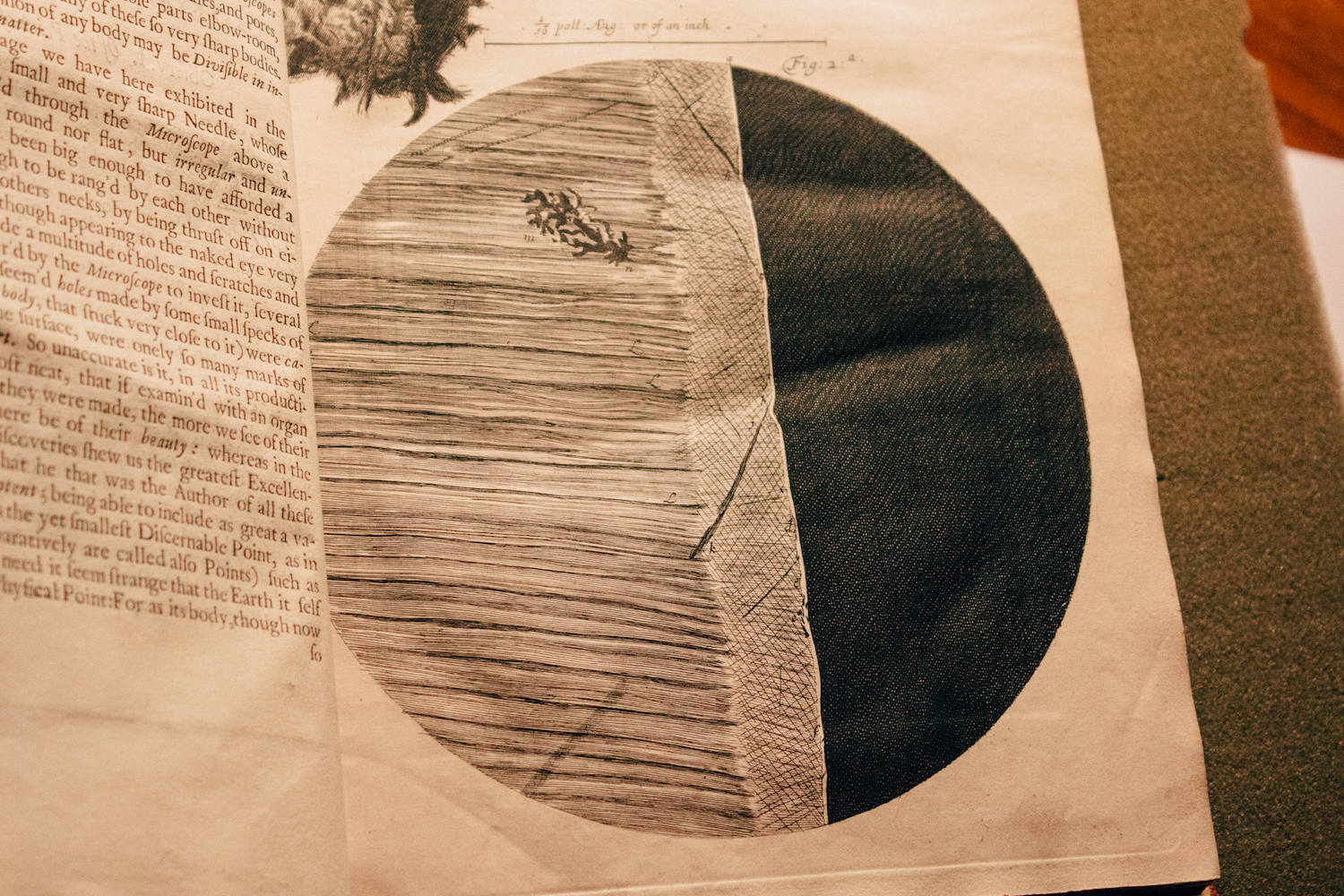
A razor blade, which appears much more uneven and less sharp than to the naked eye. Credit: Daniel Peterschmidt
“This is a Creature so officious, that ’twill be known to every one at one time or other, so busie, and so impudent, that it will be intruding it self in every ones company, and so proud and aspiring withall, that it fears not to trample on the best, and affects nothing so much as a Crown; feeds and lives very high, and that makes it so saucy, as to pull any one by the ears that comes in its way, and will never be quiet till it has drawn blood…”
—Robert Hooke in Micrographia
“Hooke loves what he’s doing, and he is so intent on providing as much detail as possible,” explains Shaner. That holds true even when it comes to describing creatures that some may consider grotesque or unsavory. “He’s looking at everything. It’s interesting to him; he wants to see what it looks like…. That’s the whole purpose of the book: To show people what the world looked like under a microscope.”
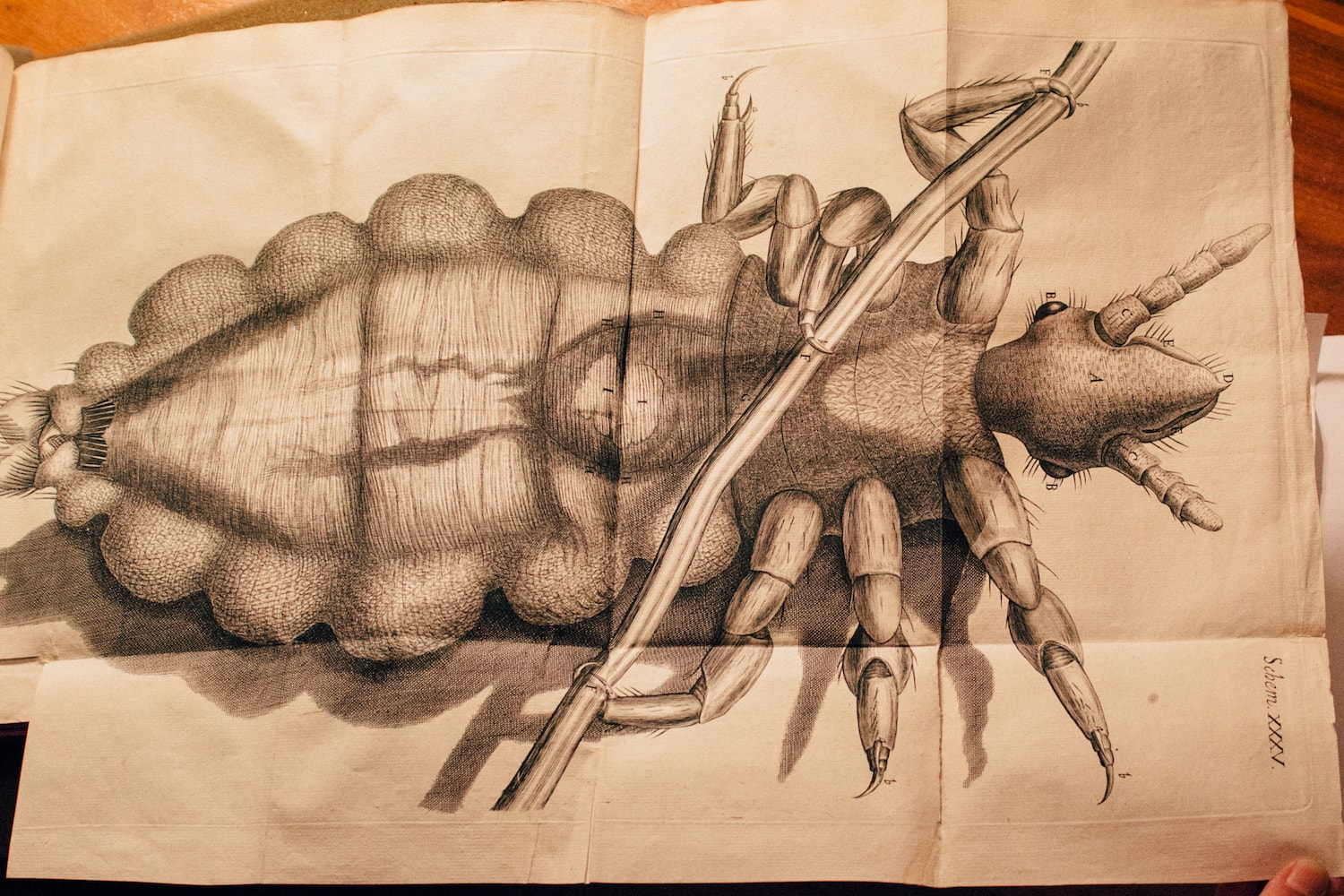
Hooke's illustration of a louse gripping a strand of hair. Credit: Daniel Peterschmidt

The eyes of a grey drone-fly. Credit: Daniel Peterschmidt
“Hooke loves what he’s doing, and he is so intent on providing as much detail as possible.”

A flea. Credit: Daniel Peterschmidt
“This was a creature, more troublesom to be drawn, then any of the rest, for I could not, for a good while, think of a way to make it suffer its body to ly quiet in a natural posture; but whil’st it was alive, if its feet were fetter’d in Wax or Glew, it would so twist and wind its body, that I could not any wayes get a good view of it; and if I killed it, its body was so little, that I did often spoile the shape of it, before I could throughly view it: for this is the nature of these minute Bodies, that as soon, almost, as ever their life is destroy’d, their parts immediately shrivel, and lose their beauty.”
—Robert Hooke in Micrographia
The description of the ant is Shaner’s favorite, because “you get this kind of very, very personal sense and account of this man who is completely fascinated by the world that he is bringing into view through this microscope, and of the various kinds of struggles that he goes through in order to create the images.” The solution that Hooke eventually landed on was to douse the ant in well-rectified spirit of wine. The ant would drown, but then the alcohol would evaporate away, and the creature would be left in a natural posture.

Hooke's observation of an ant. Credit: Daniel Peterschmidt
“[The Moon] seems to be some very fruitful place, that is, to have its surface all covered over with some kinds of vegetable substance… I am not unapt to think, that the Vale may have Vegetables analogus to our Grass, Shrubs, and Trees; and most of these incompassing Hills may be covered with so thin a vegetable Coat, as we may observe the Hills with us to be, such as the short Sheep pasture which covers the Hills of Salisbury Plains.”
—Robert Hooke in Micrographia
For this illustration, Hooke turned away from his microscope and looked through a 36-foot telescope. Why switch from the up-close to the unthinkably distant? Shaner has a hunch: “He starts out on that very first page [in the Preface] talking about human beings and the way that they think they have the prerogative to control the world, to look at things. And then he becomes, in some sense, God. He sticks all these things under the microscope and looks at them, and he controls everything. When he turns around and he looks through the telescope at the stars and the moon, essentially what he is doing is making us small again. He puts people back in their place. There is a huge universe above us, and we are little in that universe. He kind of brings that back down.”
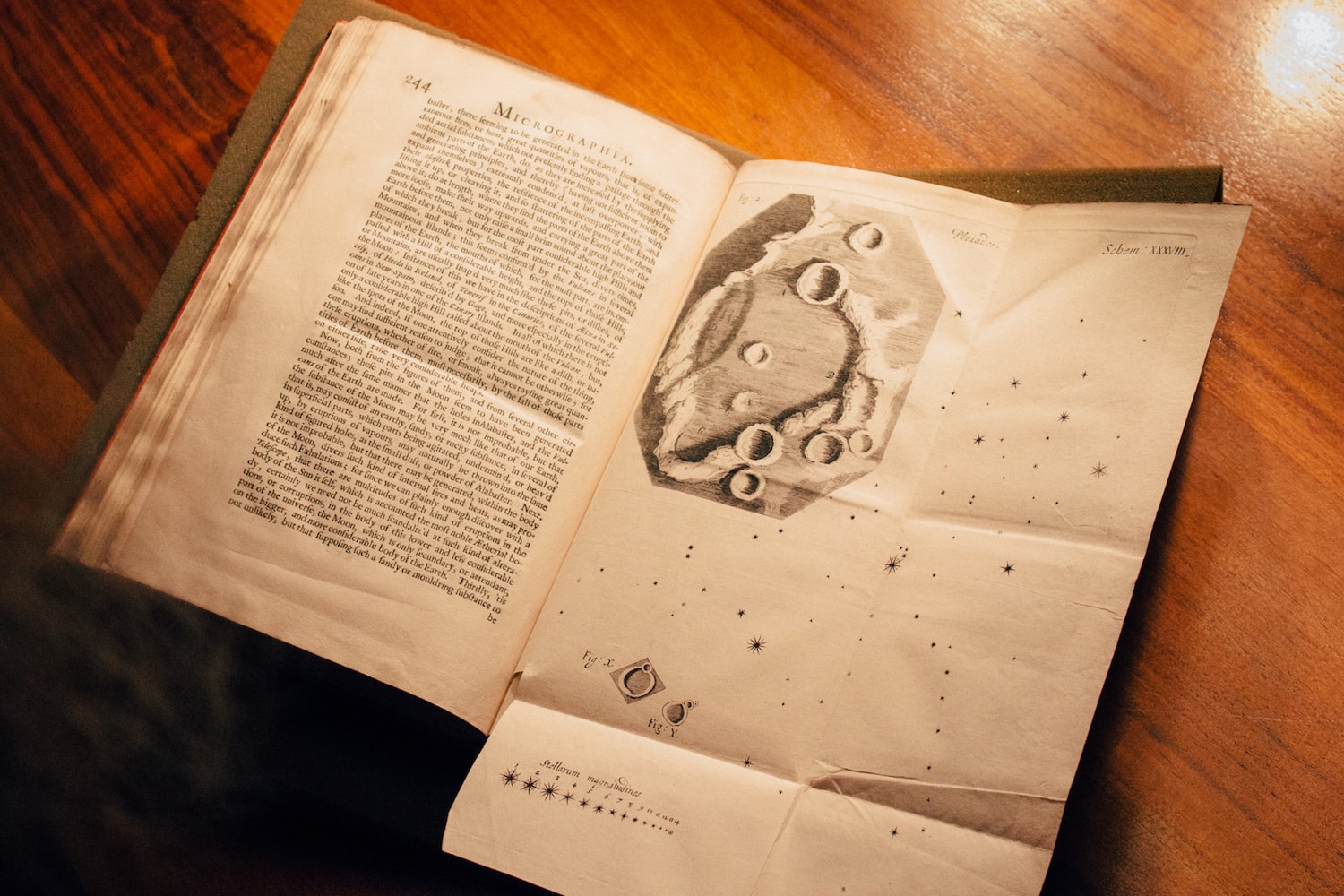
The craters of the moon, and stars. Credit: Daniel Peterschmidt
Special thanks to Arlene Shaner and the New York Academy of Medicine.
Johanna Mayer is a podcast producer and hosted Science Diction from Science Friday. When she’s not working, she’s probably baking a fruit pie. Cherry’s her specialty, but she whips up a mean rhubarb streusel as well.